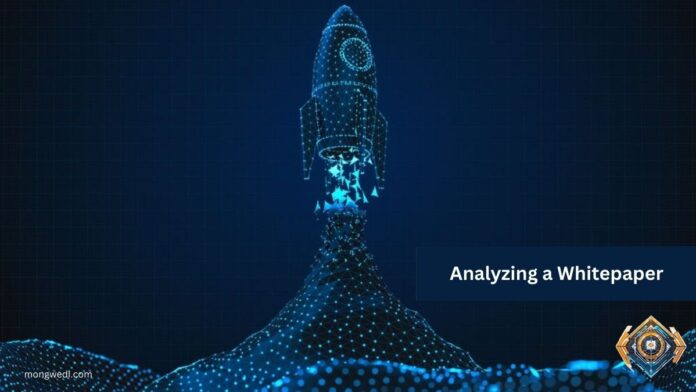Investing in an Initial Coin Offering (ICO) can be an exciting opportunity to support innovative blockchain projects and potentially earn significant returns. However, it also comes with substantial risks. One of the most important steps in evaluating an ICO is analyzing its whitepaper.
A whitepaper serves as the project’s business plan and technical blueprint, providing crucial information about the project, its goals, technology, and the team behind it.
In this comprehensive guide, we will delve into the key factors to consider when analyzing a whitepaper to make informed investment decisions.
Understanding the Basics
What is a Whitepaper?
A whitepaper is a document released by a cryptocurrency project that outlines the problem it aims to solve, its proposed solution, the technology behind it, and the details of the token sale. It’s a critical resource for potential investors to assess the viability and legitimacy of the project.
Importance of a Whitepaper
The whitepaper is often the first point of contact between the project team and potential investors. It provides transparency, builds trust, and helps investors understand the project’s vision, technical foundations, and economic model.
Key Factors to Consider
1. Problem Statement and Solution
Problem Statement
A solid whitepaper should begin with a clear and compelling problem statement. This section should explain the specific issue the project aims to address. The problem should be significant enough to warrant a blockchain solution and resonate with potential users and investors.
Questions to Consider:
- Is the problem clearly defined and significant?
- Does the project address a real need in the market?
- Is the problem statement backed by data or evidence?
Proposed Solution
Following the problem statement, the whitepaper should present the project’s solution. This section should detail how the project plans to solve the identified problem using blockchain technology.
Questions to Consider:
- Is the solution innovative and feasible?
- How does the solution leverage blockchain technology?
- Are the benefits of the solution clearly articulated?
2. Market Analysis
A thorough market analysis is essential for understanding the project’s potential for success. This section should include an overview of the industry, target market, and competitive landscape.
Questions to Consider:
- Is there a clear description of the target market?
- What is the size and growth potential of the market?
- Who are the main competitors, and how does the project differentiate itself?
3. Technical Architecture
Technology Stack
The technical architecture section should provide detailed information about the project’s technology stack, including the blockchain platform (e.g., Ethereum, Binance Smart Chain), consensus mechanism, and any unique technological innovations.
Questions to Consider:
- Is the technology stack clearly described and appropriate for the project’s goals?
- Does the project use a proven blockchain platform or introduce a new one?
- Are there any unique technological features or innovations?
Scalability and Security
Scalability and security are critical factors for any blockchain project. The whitepaper should address how the project plans to handle large volumes of transactions and ensure the security of the network.
Questions to Consider:
- How does the project plan to achieve scalability?
- What measures are in place to ensure security?
- Are there any potential technical risks or challenges?
4. Tokenomics
Token Utility
The whitepaper should explain the utility of the token within the project’s ecosystem. This includes how the token will be used, its role in the platform, and how it provides value to users.
Questions to Consider:
- What is the primary utility of the token?
- How does the token integrate into the project’s ecosystem?
- Is the token essential for the platform’s operation?
Token Distribution
Understanding the token distribution is crucial for assessing the fairness and sustainability of the project. This section should outline the total supply of tokens, allocation to different stakeholders, and any vesting periods.
Questions to Consider:
- How are the tokens distributed among team members, advisors, investors, and the community?
- Are there lock-up or vesting periods to prevent market manipulation?
- Does the distribution plan seem fair and sustainable?
Token Economics
Token economics, or tokenomics, refers to the economic model underlying the token. This includes how tokens will be generated, used, and burned, and the incentives for holding and using the token.
Questions to Consider:
- What is the token generation event (TGE) process?
- Are there mechanisms to control inflation or deflation of the token?
- How are users incentivized to hold and use the token?
5. Roadmap
A clear and detailed roadmap provides a timeline for the project’s development and milestones. It helps investors understand the project’s progress and future plans.
Questions to Consider:
- Is the roadmap realistic and achievable?
- Are there clear milestones and timelines?
- How does the project plan to achieve its goals?
6. Team and Advisors
The team behind the project is one of the most critical factors in its potential success. The whitepaper should provide information about the core team members, their backgrounds, and relevant experience.
Questions to Consider:
- Does the team have relevant experience and expertise?
- Are team members’ backgrounds verifiable and credible?
- Are there reputable advisors associated with the project?
7. Legal and Regulatory Compliance
Legal and regulatory compliance is increasingly important in the cryptocurrency space. The whitepaper should address the project’s approach to compliance and any regulatory considerations.
Questions to Consider:
- Is the project compliant with relevant regulations in its operating jurisdictions?
- Does the whitepaper address legal risks and how they will be managed?
- Are there clear disclosures about the legal structure of the token sale?
8. Community and Communication
A strong and engaged community is vital for the success of any blockchain project. The whitepaper should outline the project’s plans for community building and communication.
Questions to Consider:
- Does the project have an active and engaged community?
- How does the project plan to communicate with stakeholders?
- Are there channels for regular updates and feedback?
Deep Dive into Key Sections
Problem Statement and Solution: A Closer Look
The problem statement and solution sections are fundamental to understanding the project’s vision and purpose. Here’s how to analyze these sections in depth:
Problem Statement
A well-articulated problem statement should be specific, relevant, and backed by evidence. It should answer the following:
- What is the problem?: Clearly describe the issue the project aims to solve.
- Who is affected?: Identify the target audience or market segment that faces this problem.
- Why is it important?: Explain the significance of the problem and the impact of not addressing it.
Proposed Solution
The proposed solution should be innovative, practical, and demonstrate a clear use of blockchain technology. It should include:
- Solution Overview: A high-level description of how the project plans to address the problem.
- Technology Use: Explanation of how blockchain technology will be leveraged.
- Benefits: Clear articulation of the advantages and benefits of the solution.
Market Analysis: Understanding the Landscape
A thorough market analysis provides context for the project’s potential. This section should cover:
- Industry Overview: Description of the industry and its current state.
- Target Market: Detailed analysis of the target market, including demographics, size, and growth potential.
- Competitive Landscape: Identification of key competitors and the project’s differentiators.
Technical Architecture: Assessing the Backbone
The technical architecture section should provide a deep dive into the project’s technology. Key elements to analyze include:
- Blockchain Platform: Explanation of the chosen blockchain platform and its advantages.
- Consensus Mechanism: Description of the consensus mechanism (e.g., Proof of Work, Proof of Stake) and its implications for security and scalability.
- Unique Features: Any unique technological innovations or features that set the project apart.
Tokenomics: Evaluating the Economic Model
Tokenomics is critical for understanding the value proposition of the token. Key aspects to consider include:
- Token Utility: Clear description of the token’s utility within the ecosystem.
- Token Distribution: Detailed breakdown of token allocation and distribution mechanisms.
- Economic Model: Explanation of how the token economy works, including mechanisms for controlling supply and demand.
Roadmap: Planning for the Future
A realistic and detailed roadmap provides insight into the project’s development and future plans. Look for:
- Milestones: Clear and achievable milestones with specific timelines.
- Progress: Information on current progress and past achievements.
- Future Plans: Detailed plans for future development and expansion.
Team and Advisors: The People Behind the Project
The team’s experience and expertise are crucial indicators of the project’s potential. Evaluate:
- Team Members: Backgrounds, relevant experience, and track records of core team members.
- Advisors: Presence of reputable advisors and their contributions to the project.
- Transparency: Availability of information about team members and their roles.
Legal and Regulatory Compliance: Navigating the Legal Landscape
Legal and regulatory compliance is essential for the project’s sustainability. Consider:
- Regulatory Compliance: Information on how the project complies with relevant regulations.
- Legal Risks: Disclosure of potential legal risks and how they will be managed.
- Token Sale Structure: Clear explanation of the legal structure of the token sale.
Community and Communication: Building Engagement
A strong and engaged community is vital for the project’s success. Look for:
- Community Engagement: Evidence of an active and engaged community.
- Communication Channels: Availability of communication channels for regular updates and feedback.
- Transparency: Openness and transparency in communication with stakeholders.
Case Studies: Analyzing Real-World Whitepapers
Case Study 1: Ethereum
Problem Statement and Solution
Ethereum’s whitepaper, published by Vitalik Buterin, begins with a clear problem statement: the limitations of Bitcoin’s scripting language. It then proposes a solution: a new blockchain with a built-in Turing-complete programming language.
Market Analysis
Ethereum identified a broad target market: developers and enterprises looking to build decentralized applications (dApps). It highlighted the potential for disrupting traditional industries through smart contracts.
Technical Architecture
The whitepaper provided detailed information about Ethereum’s architecture, including its use of the Ethereum Virtual Machine (EVM) and Proof of Work consensus mechanism.
Tokenomics
Ethereum’s token, Ether (ETH), was described as the fuel for the network, used to pay for transaction fees and computational services.
Roadmap
Ethereum’s roadmap outlined the stages of development, from the initial proof of concept to the launch of the mainnet and future upgrades.
Team and Advisors
The whitepaper provided information about the core team, including Vitalik Buterin, Gavin Wood, and other key contributors.
Legal and Regulatory Compliance
Ethereum’s whitepaper addressed regulatory considerations and the legal structure of the token sale.
Community and Communication
Ethereum emphasized the importance of community engagement and outlined plans for developer outreach and community building.
Case Study 2: Filecoin
Problem Statement and Solution
Filecoin’s whitepaper identified the problem of inefficient and expensive data storage. It proposed a decentralized storage network that incentivizes users to rent out their unused hard drive space.
Market Analysis
The whitepaper provided a detailed analysis of the data storage market, highlighting the potential for cost savings and improved efficiency.
Technical Architecture
Filecoin’s technical architecture section detailed its use of Proof of Replication and Proof of Space-Time to secure the network and validate storage.
Tokenomics
Filecoin’s token (FIL) was described as the currency for transactions within the network, incentivizing storage providers and clients.
Roadmap
The roadmap outlined the stages of development, from the testnet launch to the mainnet release and future improvements.
Team and Advisors
Filecoin’s whitepaper provided information about the team, including Protocol Labs’ founder Juan Benet and other key contributors.
Legal and Regulatory Compliance
The whitepaper addressed regulatory considerations and the legal framework for the token sale.
Community and Communication
Filecoin emphasized community engagement, outlining plans for developer support and community building.
Red Flags to Watch Out For
While analyzing a whitepaper, it’s crucial to be vigilant for potential red flags that may indicate risks or problems with the project. Some common red flags include:
1. Vague or Unrealistic Claims
Be wary of projects that make vague or overly ambitious claims without providing detailed explanations or evidence. Unrealistic promises of guaranteed returns or revolutionary technology with little substantiation are red flags.
2. Lack of Transparency
Transparency is key to building trust. If the whitepaper lacks detailed information about the team, technology, or tokenomics, it may indicate a lack of legitimacy.
3. Poorly Defined Use Case
A poorly defined or weak use case suggests that the project may not have a clear problem to solve or a viable solution. The use case should be specific, relevant, and backed by evidence.
4. No Clear Roadmap
A lack of a clear and detailed roadmap may indicate that the project lacks a concrete plan for development and growth. The roadmap should outline specific milestones and timelines.
5. Inadequate Market Analysis
An inadequate or superficial market analysis may suggest that the project has not thoroughly researched its target market and competitive landscape. A detailed market analysis is crucial for assessing the project’s potential.
6. Unverifiable Team Information
If the whitepaper does not provide verifiable information about the team members and their backgrounds, it raises concerns about the project’s legitimacy. Team members should have relevant experience and a track record of success.
Conclusion
Analyzing a whitepaper is a critical step in evaluating an ICO and making informed investment decisions. By carefully examining the problem statement and solution, market analysis, technical architecture, tokenomics, roadmap, team, legal and regulatory compliance, and community engagement, investors can gain a comprehensive understanding of the project’s potential and risks.
Investing in ICOs can be highly rewarding, but it also comes with significant risks. Thorough due diligence, including a detailed analysis of the whitepaper, is essential for mitigating these risks and making sound investment choices. By following the guidelines and considerations outlined in this guide, you can approach ICO investments with greater confidence and discernment, increasing your chances of success in the dynamic and rapidly evolving world of blockchain technology.























